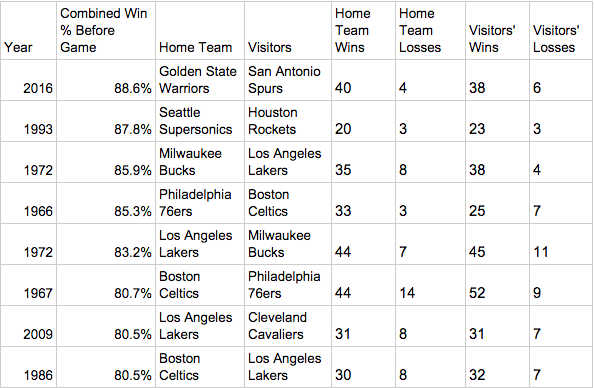At the highest levels of boxing, the marquee matchup every fan wanted to see at its peak—Floyd Mayweather in his prime vs. Manny Pacquiao in his prime—never transpired. But at basketball’s highest level, fortunately, the best cannot avoid the best. Tonight Golden State hosts San Antonio in what should be framed, by most metrics, as the greatest regular season game in NBA history.
Never before have two teams so dominant collided at midseason. Golden State and San Antonio have a combined winning percentage of 88.6 percent, nearly three percentage points higher than the combined win rate of Milwaukee and Los Angeles when those superpowers rumbled in January 1972. After the dust cleared from that showdown, Kareem Abdul-Jabbar and Oscar Robertson had ended the 33-game win streak propelled by Wilt Chamberlain and Jerry West.
Below are six other notable games featuring teams which had won at least 75 percent of their games before playing:
Most Elite Teams To Ever Meet In a Regular Season NBA Game

*All matchups were played after Christmas and before March of respective season. Statistics courtesy of Basketball-Reference.com. Above chart excerpted from a more detailed graph including final outcomes here.
Not only are Golden State and San Antonio’s overall records supreme, but few teams have ever entered such a big-time bout playing so well in recent games. The Spurs have reeled off 13 wins in a row and in Kahwi Leonard boast perhaps the one player most capable of giving Steph Curry fits. Golden State, meanwhile, pulverized East contenders Cleveland and Chicago last week and remains on track to set the all-time NBA wins record for a single season.
Oh, and another thing: there’s a strong argument these teams are so far among the top 3 in NBA history. Below are the best teams in league history according to TeamRtng+, which takes the average of a team’s offensive and defensive production and measures it against the league average.
Forget Pacquiao and Mayweather. The numbers show these squads are trending toward prime Frazier and Ali status:
Given these nearly unsurpassed twin peaks of efficiency, it’s little wonder one Spurs fan venturing onto a Warriors blog went so far as to tell Golden State fans he was “looking forward to sharing multiple basketballgasms with you tonight.”
Despite all the love being showered on these teams, some hoop cognescenti believe today’s biggest, best thing benefits from weakened competition. They don’t think today’s top teams could not dominate to the same extent in previous eras. For instance, while many of today’s younger critics assume the 72-win Bulls of 1995-96 are the standard these Warriors and Spurs aim to surpass, it should noted that at least two prominent hoopheads have gone on the record against this line of thinking.
1. Wilt Chamberlain
Before he died in 1999, the Big Dipper went into Big Doubter mode when asked to measure that decade’s great Bulls teams against the best of his own era. Chamberlain believed his ‘67 Sixers were the best of all-time despite finishing with “only” 68 wins, a smaller win total than three teams following it in future decades. By 1995 the NBA had expanded to 29 teams, but in the late 1960s the league only had 10 teams, as Chamberlain pointed out. “We were going up against Boston, the defending champion, nine times a year,” he said. “Now, win your games against the good teams and you’ve got 70 wins.”
Chamberlain’s math is a little fuzzy, but there’s little doubt were he alive today he would make a similar point about the Spurs or Warriors: They would not be on track for 70+ wins if they had to play each other—and another top contender like the Oklahoma City Thunder—nine times each this season.
2. Bill Simmons
In his 2010 tome The Book of Basketball, Boston uberfan Bill Simmons lays out a passionate argument why the ‘96 Bulls are secondary to the ‘86 Celtics as the best ever. The team’s defensive versatility—which featured four frontcourt players who would make the Hall of Fame—is a main reason:
“They even had one wrinkle that mortified opponents: a supersized lineup with a frontline of Parish, McHale and Walton, then Bird playing guard on offense (which could happen because McHale the Freak could defend almost any two-guard). Every time they played those four guys together at once, you moved to the edge of your seat.”
“On the flip, they could also handle smallball with Bird-DJ-Ainge-Wedman-McHale, or even Sichting in Wedman’s place and DJ (Dennis Johnson) playing small forward. You could not throw an opponent at them from any point in history that they wouldn’t have handled. Kinda like Dirk Diggler.”
As skilled as those Celtic guards and forwards were, it’s hard to imagine them having them having the lateral quickness necessary to contain the Warriors’ ultra versatile and proficient “Death Ball” lineup of Andre Iguodala, Curry, Draymond Green, Klay Thompson and Harrison Barnes for an entire game.
Of course, it’s hard to imagine any one team with the depth, length and quickness needed to do that.
***
Tonight’s game, which Golden State enters as a five-point favorite, is only the first of four regular season bouts between the teams. A playoff series could produce up to seven more games. Expect the coaches to strategize tonight with those later meetings in mind.
Already, we know Spurs coach Gregg Popovich will bench Tim Duncan to alleviate his right knee soreness. Pop, wily tactician he is, may choose not to unveil during this game specific lineups he has in mind for countering “Death Ball” in a possible playoff showdown. For that matter, Warriors coach Steve Kerr could decide it’s not in his team’s best long-term interest to even allow the Spurs to get defensive reps against it.
It’s hardly any loss for basketball fans if the coaches hold back. Even when operating at 95 percent, these two teams are still far ahead of the pack.
—
Photo via Getty Images